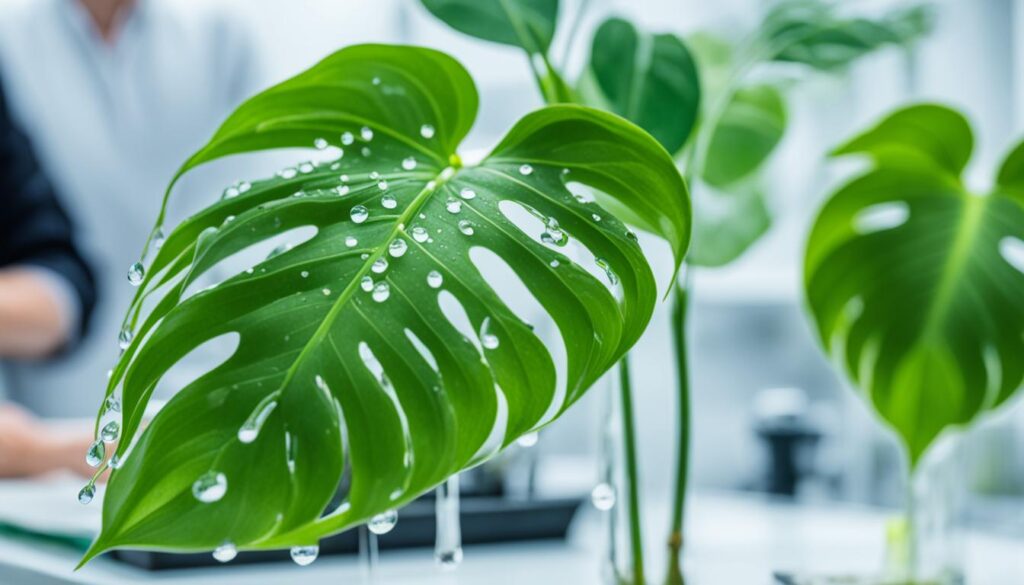Did you know the philodendron radiatum can grow leaves up to 90 cm long and 70 cm wide? This evergreen climber is a real showstopper. Its leaves have deep cuts that make it stand out. It’s not just pretty; it’s also useful, used in medicine and for making baskets.
This plant comes from Northern South America and Central America. It loves the wet forests of the lowlands. You can find it climbing trees or on the ground, from sea level to 2,000 meters high. It’s considered wild but is loved by plant lovers for its unique look and how well it adapts.
Key Takeaways
- The philodendron radiatum is a rare and stunning tropical plant with large, deeply incised leaves that can grow up to 90 cm long and 70 cm wide.
- It is a vigorous, evergreen climbing shrub that is usually epiphytic on trees but can also be found growing on the ground.
- The plant has aerial roots that are used locally to make baskets, and it also has minor medicinal uses.
- The large leaves are often used as decorations on altars in Guatemala.
- Philodendron radiatum is native to Northern South America and Central America, where it thrives in the wet forests of the lowland tropics.
Botanical Classification and Synonyms
The philodendron radiatum falls under the Araceae family, also known as the arum or aroid family. This family includes over 3,700 species spread across more than 120 genera. Philodendron radiatum is part of the Genus Philodendron.
Philodendrons are the second-largest group in the Araceae family, after Anthurium. But, the study of philodendrons is still ongoing. Many species are yet to be identified. The name “Philodendron” comes from Greek words. “Philo” means “love” and “dendron” means “tree,” showing the plant’s love for growing on trees.
Schott Araceae
Philodendron radiatum has a few other names, including:
- Philodendron augustinum K.Koch
- Philodendron impolitum Schott
- Philodendron polytomum Schott
These names show the changes in classification and understanding of philodendron radiatum and the Philodendron genus over time.
What is a philodendron radiatum?
The philodendron radiatum is a beautiful tropical plant. It has large, deeply cut leaves that can reach up to 90 cm long and 70 cm wide. This evergreen climbing shrub thrives on trees or as a ground plant.
It’s originally from Central America, South America, and the Caribbean. You can find it in wet forests, from sea level to about 2,000 meters high. It loves strong indirect light but can handle some direct sun.
This plant is rare and special, known as a “Rare and Unusual Plant.” It grows to about 0.00 meters tall. It needs a specific care routine to stay healthy.

“Philodendron radiatum prefers moist, well-drained, humus-rich soil, thriving best at elevations from near sea level to around 700 meters, but can be found as high as 2,000 meters.”
Philodendron radiatum is not just pretty; it has medicinal uses. The leaves are used in decoctions for treating pain and rickets. Its aerial roots are used in basket-making.
Philodendron Radiatum: A Vigorous Climbing Shrub
The philodendron radiatum plant stands out with its unique look and fast growth. It’s an evergreen climbing shrub that loves to grow on trees and sometimes on the ground. This plant is known for its ability to thrive in different environments.
General Information and Leaf Characteristics
As the philodendron radiatum grows, its leaves change shape. Young plants have small, heart-shaped leaves. But as they get bigger, the leaves grow larger and more complex, reaching up to 90 cm long and 70 cm wide.
Each mature leaf side has 5 to 10 lobe segments. This makes the leaves deeply pinnatifid, or deeply incised and lobed. The plant can grow almost a meter tall in the wild. Its stems bend towards the sun, so it needs regular turning to look great from every side.
Philodendron radiatum is not a hardy plant and should be moved indoors when it gets cold. It loves bright, indirect sunlight and does best in temperatures between 13°C and 27°C. It also needs humidity above 60% to stay healthy.
Growth Habitat and Range
The philodendron radiatum is a versatile plant that can grow in many places. It often grows as an epiphyte, using trees or other plants for support. Its roots stick to the host plant, not the soil. But, it can also live as a terrestrial plant, with roots in the ground.
This plant is originally from northern South America, including Colombia. It moves north through Central America to Mexico. You can find it from sea level up to about 2,000 meters high.

“Philodendrons are among the most important and well-known tropical plants, with a wide range of species and cultivars that are widely grown as houseplants and in gardens.”
Epiphytic or Terrestrial Growth
- The philodendron radiatum often grows as an epiphyte, sticking to trees and other structures.
- But, it can also live as a terrestrial plant, with roots in the soil.
- Epiphytic growth is more common, as the plant climbs trees to get sunlight.
Native Range
- The philodendron radiatum comes from northern South America, including Colombia.
- It spreads north through Central America to Mexico.
- It lives from sea level up to about 2,000 meters high.
Caring for Philodendron Radiatum
Philodendron radiatum is a beautiful tropical plant that needs careful attention to grow well. Gardeners should focus on the right care for this plant. This includes the right growing conditions and temperature during its flowering stage.
Cultivation Requirements
This plant likes moist, well-drained soil that’s rich in humus and partial shade. It also does well with occasional feedings that are high in magnesium. Philodendron radiatum can heat its spadix as pollen gets ready for pollination. This makes the plant more attractive to pollinators.
Heating Effects During Flowering
When it flowers, philodendron radiatum can get hotter to help with pollination. This special feature draws in pollinators and makes the plant’s scent stronger. Gardeners should watch the temperature closely during this time.
Knowing how to care for philodendron radiatum and its heating during flowering helps gardeners. This ensures the plant grows well and looks great.
Medicinal Uses of Philodendron Radiatum
The philodendron radiatum is more than just a pretty plant. It has many medicinal uses, showing its value beyond looks.
Decoction of Leaves for Rheumatic Pain and Rickets
People use a decoction of the philodendron radiatum leaves to treat pain from rheumatism and rickets. This method has been used for a long time, showing its trust in folk medicine.
Caution Advised Due to Calcium Oxalate Crystals
The plant has calcium oxalate crystals that can be harmful if eaten fresh. So, it’s wise to be careful when using it for medicine. Experts should watch over its use.
“Philodendrons are particularly effective at removing formaldehyde from indoor air, a known human carcinogen commonly found in building materials.”
Even with caution, the philodendron radiatum has many benefits. It can clean the air, add moisture, and even lower stress and anxiety. These features make it a great choice for any space.

Other Uses: Basketry and Decorations
The Philodendron radiatum, a stunning tropical plant, is more than just beautiful. It has many uses, especially in basketry and decorations.
Artisans use the Philodendron radiatum‘s aerial roots to make intricate baskets. These roots are flexible and strong, perfect for weaving baskets. This makes the plant a key part of local crafts.
The Philodendron radiatum is also a big part of cultural decorations. Its large, lush leaves are often used on altars in Guatemala. They add a touch of tropical beauty to these sacred places.
“The aerial roots of Philodendron radiatum are used locally to make baskets, while the large leaves of the plant are much used as decorations on altars in Guatemala.”
The Philodendron radiatum shows how versatile and culturally important it is. It’s used for both practical things like baskets and for making beautiful decorations. This plant continues to inspire and captivate people everywhere.
Propagation Methods
Philodendron radiatum is a beautiful tropical plant that can be grown in many ways. You can expand your plant collection or share it with others. You can choose from seed germination or vegetative propagation, depending on what you like.
Seed Germination
Starting Philodendron radiatum from seeds is an exciting way to grow more plants. Seeds germinate best at about 20°C (68°F). With patience and the right conditions, you can see these tropical plants grow from seeds.
Vegetative Propagation Techniques
Philodendron radiatum can also be grown using vegetative methods. You can use air layering, stem tip cuttings, or leaf bud cuttings. Stem cuttings of 6-8 inches with at least 2 nodes work best for growing new plants. You can use water or soil to propagate, but taking good care of the cuttings is key for a healthy plant.
Choosing the right method to propagate Philodendron radiatum is important. It’s best to use a healthy, mature plant as the parent. This ensures the new plants will grow strong and healthy.

“Propagating philodendrons can be a rewarding experience, allowing you to create new plants and share the beauty of this genus with others.”
Whether you’re experienced or new to plants, trying different ways to propagate Philodendron radiatum can be exciting. By learning the best practices, you can grow and share this beautiful tropical plant.
Safety Precautions with Calcium Oxalate
Philodendron radiatum, like many in the Araceae family, has calcium oxalate crystals. These can be harmful if eaten fresh. They make your mouth, tongue, and throat feel like they’re on fire. But, cooking or drying the plant removes this danger.
Be careful with Philodendron radiatum, especially when trimming or spreading its roots. The crystals can bother your skin and eyes. Always wear gloves and eye protection. If you touch the plant by mistake, get medical help right away. Call the Pet Poison Helpline® at (855) 764-7661.
- Philodendron radiatum contains calcium oxalate crystals, which can be toxic if consumed fresh.
- Ingesting the plant can cause a burning sensation in the mouth, tongue, and throat.
- The toxicity can be eliminated by thoroughly cooking or drying the plant.
- Handle Philodendron radiatum with care, wear gloves and eye protection when working with it.
- Seek immediate medical attention if exposed to the plant’s calcium oxalate crystals.
Always put safety first when taking care of Philodendron radiatum or plants with calcium oxalate. By being cautious, you can enjoy this beautiful tropical plant safely. This way, you and your loved ones stay safe.
Philodendron Radiatum in the Wild
Philodendron radiatum is a beautiful tropical plant that thrives in its natural setting. It grows as an epiphyte on tree trunks and branches in wet, tropical forests. It can be found from sea level up to about 2,000 meters high. This lets it live in many different philodendron radiatum wild habitat and philodendron radiatum natural habitat conditions.
Typical Habitat Conditions
The philodendron radiatum plant loves the lush, humid world of tropical rainforests. It sticks to tree bark, using its aerial roots to get nutrients and moisture. In these philodendron radiatum wild habitat spots, its leaves can grow almost a meter long, with 5 to 10 lobe segments on each side.
“Philodendron radiatum is a rare and fascinating tropical plant that thrives in the humid, shaded forests of its natural habitat.”
This plant can live at many heights, from sea level up to 2,000 meters. Its ability to adapt shows its strength and flexibility. It grows in various regions of Central and South America, amazing botanists and nature lovers.

Bringing the Tropics Home
Philodendron radiatum, with its deep-lobed leaves, can do well indoors with the right care. This climbing shrub from the tropics brings a lush, exotic feel to any room.
Indoor Growing Tips
To grow philodendron radiatum indoors, follow these tips:
- It needs bright, indirect light. Put the plant near a sunny window but keep it away from direct sunlight.
- Keep the soil moist but well-drained. Water it when the top inch of soil feels dry. Don’t let it sit in water.
- Feed it a balanced liquid fertilizer every 4-6 weeks during the growing season. This gives it the nutrients it needs.
- Keep it away from cold drafts and sudden temperature changes. It likes warm, humid places.
With the right philodendron radiatum indoor growing conditions and philodendron radiatum care indoors, this plant can flourish. It will bring a touch of the tropics to your home.
“Philodendrons, including the radiatum variety, have been linked to lower stress, better focus, and a happier mood. They positively affect mental health and well-being in indoor settings.”
Philodendron Radiatum Varieties
The philodendron radiatum is a unique plant in the Philodendron family. It doesn’t have many varieties or cultivars. Gardeners and botanists love it for its special leaves and how it grows.
This plant can grow leaves up to 90cm (3 feet) long under the right conditions. Its leaves have 5 to 10 lobe segments, making them look stunning. It’s found in Northern South America, Central America, and Mexico.
Researchers have found at least ten different types of philodendron radiatum in the wild. These types vary in how deeply their leaves are cut. The usual type has deeply cut leaves, while pseudoradiatum has leaves that are only a bit cut.
The plant’s flowers are quite big, measuring 20 to 26cm (8 to 10 inches). The spathe is green with red tints, and the inside is a deep purple-violet color.
Whether you grow it indoors or see it in nature, the philodendron radiatum is a beautiful plant. It shows how diverse and lovely the Philodendron family can be.

Pruning and Maintaining Philodendron Radiatum
Philodendron radiatum is a beautiful tropical plant that needs some care to stay healthy and look great. Pruning it regularly helps control its size and shape. This makes sure it stays a lovely part of your indoor or outdoor area.
The best times to prune philodendron radiatum are in spring and summer. This is when it grows the most. Cutting back above the nodes encourages new growth and full foliage. If leaves get too big, they can compete for resources, so pruning is key for the plant’s health.
When you prune, use sharp pruners or scissors for clean cuts. This prevents damage and helps the plant heal faster. After cutting, water the plant gently to help it recover. Watch for any yellow leaves and adjust your care if needed.
Keeping philodendron radiatum healthy also means regular maintenance. This includes:
- Providing bright, indirect light, as it can’t handle direct sunlight
- Keeping the soil moist, but not too wet or dry
- Feeding it a nitrogen-rich fertilizer every two weeks when it’s growing
- Checking for pests like aphids, spider mites, and scale, and dealing with them quickly
By following these philodendron radiatum pruning and care tips, your plant will stay healthy and look amazing in your space.
“Regular pruning and maintenance are essential for keeping philodendron radiatum in top condition, allowing it to thrive and showcase its stunning foliage.”
Conclusion
The Philodendron radiatum is a stunning tropical plant that brightens any indoor or outdoor area. It has striking foliage and vibrant growth. Gardeners can enjoy its beauty for years by understanding how to care for it.
This plant is great as a trailing vine or a statement floor plant. Its large, deeply lobed leaves and easy nature make it a favorite among plant lovers. It prefers temperatures between 55 to 80°F and needs over 60% humidity to thrive.
With proper care in fertilizing, watering, and controlling pests, the Philodendron radiatum can grow up to 10 feet tall. It’s resilient and adaptable, making it a great choice for any plant collection. This lets gardeners bring the tropics into their homes.


